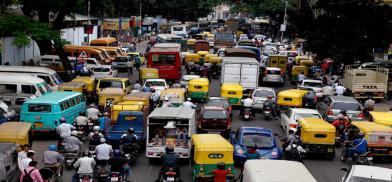India to experience behavioural change in urban mobility; non-motorised transport will occupy prime position
India is witnessing the arrival of a new generation of mobility discourses, which are nuanced enough to provide sustainable urban mobility, says Hardeep Singh Puri, India's Urban Development Minister

We are facing a global health crisis unlike any in the history of mankind - one that is spreading human suffering, infecting the global economy thereby upsetting people’s lives.
As per the United Nations Human Settlements Programme, with an estimated 90 percent of all reported COVID-19 cases, urban areas have become the epicenter of the pandemic. Urban centres, which were amidst the mobility renaissance, came to a halt, disrupting normal everyday life, commuting, and leisure trips for many millions of people across the globe. Thus, it is one area that calls for a critical re-assessment as to how we can shift to more sustainable and efficient mobility. Public transport systems around the world have seen ridership and revenue plummet, owing to the lockdowns and have been forced to cut services. Countries around the world have been grappling with ways to mitigate the adverse impact on the economy while simultaneously safeguarding lives from the deadly virus.
Rail based on urban transport systems are emerging as key solutions to fulfill the demand for urban transportation in India. To streamline the proliferation of metro rail systems in India, my Ministry had envisaged the “Metro Rail Policy-2017” that seeks to enable realization of growing metro rail aspirations of a large number of cities but in a responsible manner. The policy entails a higher than before mandate of Public-Private Partnership (PPP), in terms of funding obligations.
With about 700 km of operational network and another 900 km in the pipeline in 27 cities, the Ministry endeavors to connect 50 cities and towns by 2024 with a metro network. The policy also envisages other systems such as Metro Lite and Metro Neo, which are envisaged to fulfill the aspirations of smaller towns and cities to have a modern, yet affordable public transport system.
In the aftermath of the ongoing Covid-19 pandemic, India is likely to experience a behavioral change in urban mobility. This crisis also presents an opportunity to guide the recovery of urban transport towards long-term development goals. As articulated by Hon’ble Prime Minister, Shri Narendra Modi that the present crisis should be turned into an opportunity to create an 'Atma Nirbhar Bharat', and the time is ripe enough to make bold decisions and investments. Atma Nirbhar Bharat essentially means “self-reliant India”.
Investment in infrastructure to address more effective circulation and interchange of people and goods will have an economic multiplier effect — both job-creation in the present and boosting growth and productivity in the future.
India is witnessing the arrival of a new generation of mobility discourses, which are nuanced enough to provide sustainable urban mobility. The Ministry has issued a detailed advisory, as to how the nation needs to move ahead in these testing times. It rests on three key pillars, namely, promotion of public transport system, leveraging technological advancements, and penetration of NMT systems in the urban transport paradigm.
Future mobility is about striving towards environment-friendly, integrated, automated, and personalized travel on-demand. New advancements like intelligent transportation systems, and traffic management applications are in the pipeline for enhanced mobility in major cities.
Various studies show that about 16-57% of urban commuters are pedestrian and about 30-40% of commuters use bicycles in the country depending on the size of the city. Considering this as an opportunity, elevating the priority of these modes gives travelers another private vehicle alternative, which is clean, safe, secured particularly if it is integrated with other modes and affordable for all.
Non-motorised transport will occupy the prime, non-negotiable, position in every form of urban mobility discourse, and intervention.
The pandemic has forced all of us – Governments, administrators, and the people, to pause and introspect. There are no easy answers. One thing is clear. Cities will have to be ready for all types of contingencies. Urban transport which is the driver of economic activity will need to be firewalled to the extent possible. Innovative solutions such as flexible working hours, work from home, which was hitherto not mainstream will need to be embedded more deeply.
Finally, citizens will need to be more cautious, disciplined, and willing to be flexible in order to adapt and adhere to the steps put in place by city Governments and transport authorities in the larger public interest.
(Excerpted with permission from a speech by Hardeep Singh Puri, India's Minister of State for Housing and Urban Affairs (Independent Charge), at the inaugural session of the first virtual 13th Urban Mobility India Conference and Exhibition, 2020 on Emerging Trends in Urban Mobility on November 10)










Post a Comment